In the heart of China’s agricultural landscapes, a humble yet invasive plant, Erigeron canadensis, is revealing its potential to revolutionize the way we tackle soil heavy metal contamination. A recent study published in *Ecotoxicology and Environmental Safety* sheds light on how this plant, often considered a nuisance, could become a powerful ally in the fight against environmental pollution, with significant implications for the agriculture sector.
Erigeron canadensis, known for its robust biomass and tolerance to heavy metals, has been found to excel in phytoremediation—the process of using plants to clean up contaminated soil. The study, led by Wendi Lan from the College of Bioscience and Biotechnology at Hunan Agricultural University, explored how the plant’s rhizosphere—the soil region influenced by root secretions—plays a crucial role in this process.
The research team examined the plant’s performance across three regions with varying levels of heavy metal pollution: Huayuan County, Liuyang City, and Yueyang City. They discovered that E. canadensis showed a remarkable ability to absorb cadmium (Cd) and lead (Pb) in mildly polluted environments. “The plant’s efficiency in heavy metal uptake was influenced by soil properties such as pH, total nitrogen, and organic matter,” Lan explained. “But what truly surprised us was the role of the rhizosphere microbial community in enhancing this process.”
The study found that the rhizosphere environment facilitated the plant’s adaptation and heavy metal enrichment by altering the microbial community. Specifically, it reduced overall microbial diversity while increasing the relative abundance of key taxa with metal resistance and plant growth-promoting abilities. “Microorganisms like Lysobacter, Corynebacterium, Humicola, and Colletotrichum adapted to Cd/Pb stress with specific genes and enzymes related to heavy metal transport and uptake,” Lan noted.
This research not only elucidates the relationship between rhizospheric ecological factors and phytoremediation but also opens doors for commercial applications in the agriculture sector. By identifying and cultivating these beneficial microbial taxa, farmers and environmental managers could develop bioinoculants—microbial preparations that enhance phytoremediation efficiency. This could lead to more effective and sustainable solutions for soil decontamination, ultimately improving agricultural productivity and food safety.
Moreover, the study provides valuable insights into the management of invasive species. Instead of viewing E. canadensis solely as a nuisance, its potential for ecological restoration can be harnessed. “This research challenges our perception of invasive species and offers a new perspective on how they can be managed and utilized for environmental benefits,” Lan added.
The findings also highlight the importance of understanding the complex interactions between plants, soil, and microorganisms. As we face increasing environmental challenges, such knowledge becomes invaluable in developing innovative and sustainable agricultural practices.
In the broader context, this study underscores the need for interdisciplinary research that bridges ecology, microbiology, and agronomy. By doing so, we can uncover novel solutions that address both environmental and agricultural challenges, paving the way for a more sustainable future.
As the agriculture sector continues to grapple with the impacts of pollution and climate change, the insights from this research offer a glimmer of hope. By leveraging the natural abilities of plants like Erigeron canadensis and the beneficial microbes in their rhizosphere, we can strive towards cleaner soils, healthier crops, and a more resilient agricultural ecosystem.

